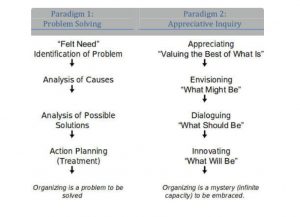5-D-Cycle of Appreciative Inquiry
The 5-D-cycle of Appreciative Inquiry offers a generative yet practical, process model for approaching change at all levels within a system, from one-on-one coaching, to team building, to system-wide change. It is a collaborative, strenghts-based approach to change.
How appreciative inquiry works?
These are the five phases of appreciative inquiry.
- Define – What is the topic of inquiry? – This first step encompasses the project’s purpose, content, and what needs to be achieved. In this phase, the guiding question is, “What generative topic do we want to focus on together?” This first step of the cycle is a recent addition to the originally 4Ds (discover, dream, design and destiny). Definition defines the topic.
- Discover – Appreciating the best of ‘what is’ – Discovery is based on a dialogue, as a way of finding ‘what works’. It rediscovers and remembers the organization or community’s successes, strengths and periods of excellence.
- Dream – Imagining ‘what could be’ – Imagining uses past achievements and successes identified in the discovery phase to imagine new possibilities and envisage a preferred future. It allows people to identify their dreams for a community or organization; having discovered ‘what is best’. They have the chance to project it into their wishes, hopes and aspirations for the future
- Design – Determining ‘what should be’ – Design brings together the stories from discovery with the imagination and creativity from dream. We call it bringing the ‘best of what is’ together with ‘what might be’, to create ‘what should be – the ideal’.
- Destiny – Creating ‘what will be’ – The fifth stage in the 5Ds process identifies how the design is delivered, and how it is embedded into groups, communities and organizations. In early appreciative inquiry development, it was called ‘delivery’, based on more traditional organizational development practice.
This is a process description of the appreciative inquiry.

In order to fully understand the principles, you are encouraged to watch this YouTube tutorial (Townsin, J. 2013. Appreciative Inquiry, 3:45 min)
